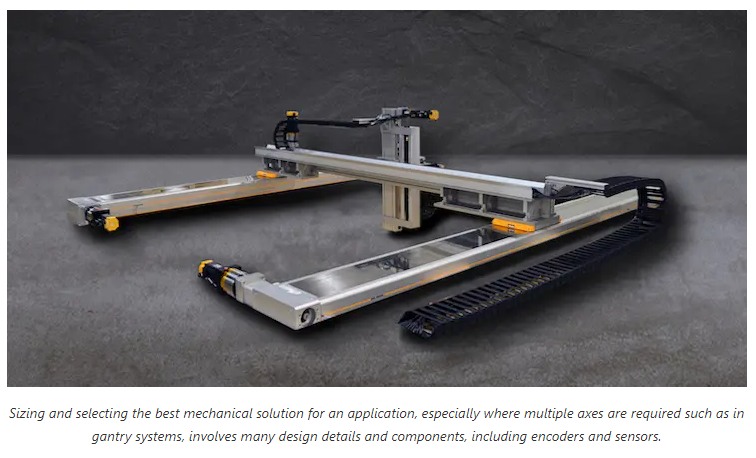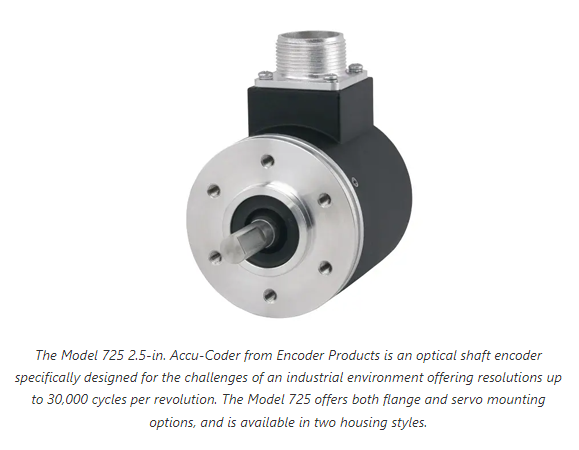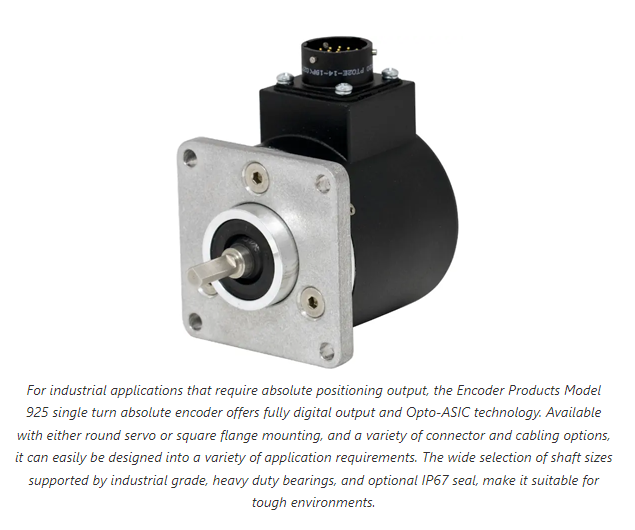Resources
Absolute Encoders — Facts and Misconceptions
Submitted by Ray Marquiss || Valin Corporation
There are two parts of motion control systems often overlooked or misunderstood; encoders for either the motor rotation or the actual position of the actuator, and the limit and home sensors used for mechanical safeguarding and positional orientation. Encoders are ubiquitous on nearly all motion for industrial applications. Home and limit sensors are also used for almost every application. However, in an effort to limit cost or perceived complexity, machine builders may determine that the use of a home sensor and in some cases, limit sensors, is not required. They either mistakenly rely only on the encoder or don’t understand the encoder they are using.
Consider a linear actuator for an automated machine that is controlled by a motion controller or PLC to move to programmable positions along its stroke.
There are two basic types of encoders customarily employed for motion control applications. The first and, until recently, most common type is the incremental encoder. The other is the absolute encoder. Both are similar in as much as they keep track of motor rotational position by basically counting pulses.
These pulses are fed back to the motion controller to confirm the position of the actuator. These pulses can be scaled into engineering units in the motion controller so that positions can be displayed and entered in easily understood units.
 It’s customary for most applications to have sensors in at least three different positions on the actuator; one at a known mechanical position used to align the motor encoder and the motion controller position, and one at each end of the actuator’s limit of travel. These are typically referred to as the “home” or “origin” sensor and the “limit” sensors (positive limit and negative limit).
It’s customary for most applications to have sensors in at least three different positions on the actuator; one at a known mechanical position used to align the motor encoder and the motion controller position, and one at each end of the actuator’s limit of travel. These are typically referred to as the “home” or “origin” sensor and the “limit” sensors (positive limit and negative limit).
It’s also important to understand the differences between absolute and incremental encoders. Both types report their positions back to the motion controller in a similar fashion. Technically, it’s done by different types of signals, but the end result is the same in the motion controller. The important distinction is how and when the “home” or “origin” position is established. With incremental encoders, a mechanical home position is established after a power cycle, most often by moving to the home sensor. In a home-search procedure, the actuator is moved slowly until the home sensor detects it. Then, the motion controller sets its position counter to a known value, most often zero. From this point on, the position is tracked using data received by the encoder as the actuator is moved. A power cycle or crash would necessitate performing the home-search procedure again.
With absolute encoders, the mechanical home position is found the same way it is with an incremental encoder. The difference is that one of several methods is used to back up the encoder so that a power cycle or crash does not force performing a home-search procedure again. Therefore, the procedure is usually only done once when the machine is commissioned. Whether absolute or incremental encoders are used has nothing to do with making absolute and incremental moves from the motion controller, nor does one inherently provide better accuracy.
 Before continuing with how the limit and home sensors work with the encoder, it’s important to note a few things about absolute encoders; their advantages, and the way their values are backed up. Absolute encoders can offer substantial time savings on machine with long actuators (say, 1 m or more) because the home-search routine is typically slow, with the actuator moving at less than 100 mm per second while it tries to find the home sensor. With absolute encoders, the home-search procedure can be skipped, and machine operation can start more quickly after a power cycle because that important position information is backed up during a power cycle.
Before continuing with how the limit and home sensors work with the encoder, it’s important to note a few things about absolute encoders; their advantages, and the way their values are backed up. Absolute encoders can offer substantial time savings on machine with long actuators (say, 1 m or more) because the home-search routine is typically slow, with the actuator moving at less than 100 mm per second while it tries to find the home sensor. With absolute encoders, the home-search procedure can be skipped, and machine operation can start more quickly after a power cycle because that important position information is backed up during a power cycle.
The method used for backing up absolute encoders has been traditionally done by batteries. A battery either connected to the amplifier or inline with the encoder cable connected to the motor is used to keep enough power to the encoder so that it will be able to hold the position information during power cycles. The home-search routine is done once, typically when commissioning the machine, and then not needed again. That is, it’s not needed until the battery goes dead and the encoder information is lost. That’s a disadvantage to the absolute encoder.
Manufacturers have addressed the battery problem in recent years by finding ways to store the position data without the use of batteries. There are a few ways to accomplish this, but the operation of and information from the encoders is the same regardless of how the battery is eliminated. Now the machine builder can take advantage of the benefits of an absolute encoder without worrying about the battery dying. In addition, the price of motors with absolute encoders has been steadily going down to the price point of motors with incremental encoders. In fact, many suppliers offer motors or actuators only with battery-less absolute encoders now.
There is another benefit of using absolute encoders without a battery though. Machine builders are often under pressure to create custom machines in a tight timeframe. Often when absolute encoders are used, they don’t get around to creating the procedure for an easy “re-homing” to initialize the absolute encoder after a battery goes dead. Many times customers who found that their machine no longer knows where it is because the battery went dead, and there was no procedure programmed into the HMI and controller to help make the replacement of the battery and re-homing easy, leading to lost productivity while they figured it out.

One of the practices to discourage is when designers want to save a little money or complexity and simply have one sensor on their actuator because they are using absolute encoders. The thinking is that this sensor will be used for the home sensor during the initialization of the absolute encoder on the first use. Afterwards, they think there is no need for limit switches because the machine knows where it is, and “soft limits” can be set to make sure that the operator or operation doesn’t move past those limits. However, experience shows that the cost of the home and limit sensors is more than recouped by the time saved when using an absolute encoder. If minutes are saved during every power cycle of the machine, the price of those switches is negligible. Besides, they provide redundancy for unexpected situations that can arise, and things can happen that will defeat any encoder’s ability to report the correct position back to the motion controller. A loose coupling on the connection between the motor shaft and the actuator shaft, for instance, could lead to a situation where the actuator is not where the motion controller thinks it is because the motor will get out of synch with the actuator in this case.
If you’re designing a new motion control application and are considering the basic elements for that control (the encoder and sensors), don’t cut corners. The cost and complexity of absolute encoders, and the benefits of using them, is such that they should be considered the standard for the position feedback. At the same time, adding simple, low-cost sensors for the home and limit positions adds so little cost to the application and provides benefits that pay back the expense, so they should be included every time.
Article featured in Design World Magazine
Consider a linear actuator for an automated machine that is controlled by a motion controller or PLC to move to programmable positions along its stroke.
There are two basic types of encoders customarily employed for motion control applications. The first and, until recently, most common type is the incremental encoder. The other is the absolute encoder. Both are similar in as much as they keep track of motor rotational position by basically counting pulses.
These pulses are fed back to the motion controller to confirm the position of the actuator. These pulses can be scaled into engineering units in the motion controller so that positions can be displayed and entered in easily understood units.

Absolute Versus Incremental Encoders
It’s also important to understand the differences between absolute and incremental encoders. Both types report their positions back to the motion controller in a similar fashion. Technically, it’s done by different types of signals, but the end result is the same in the motion controller. The important distinction is how and when the “home” or “origin” position is established. With incremental encoders, a mechanical home position is established after a power cycle, most often by moving to the home sensor. In a home-search procedure, the actuator is moved slowly until the home sensor detects it. Then, the motion controller sets its position counter to a known value, most often zero. From this point on, the position is tracked using data received by the encoder as the actuator is moved. A power cycle or crash would necessitate performing the home-search procedure again.With absolute encoders, the mechanical home position is found the same way it is with an incremental encoder. The difference is that one of several methods is used to back up the encoder so that a power cycle or crash does not force performing a home-search procedure again. Therefore, the procedure is usually only done once when the machine is commissioned. Whether absolute or incremental encoders are used has nothing to do with making absolute and incremental moves from the motion controller, nor does one inherently provide better accuracy.

The method used for backing up absolute encoders has been traditionally done by batteries. A battery either connected to the amplifier or inline with the encoder cable connected to the motor is used to keep enough power to the encoder so that it will be able to hold the position information during power cycles. The home-search routine is done once, typically when commissioning the machine, and then not needed again. That is, it’s not needed until the battery goes dead and the encoder information is lost. That’s a disadvantage to the absolute encoder.
Manufacturers have addressed the battery problem in recent years by finding ways to store the position data without the use of batteries. There are a few ways to accomplish this, but the operation of and information from the encoders is the same regardless of how the battery is eliminated. Now the machine builder can take advantage of the benefits of an absolute encoder without worrying about the battery dying. In addition, the price of motors with absolute encoders has been steadily going down to the price point of motors with incremental encoders. In fact, many suppliers offer motors or actuators only with battery-less absolute encoders now.
There is another benefit of using absolute encoders without a battery though. Machine builders are often under pressure to create custom machines in a tight timeframe. Often when absolute encoders are used, they don’t get around to creating the procedure for an easy “re-homing” to initialize the absolute encoder after a battery goes dead. Many times customers who found that their machine no longer knows where it is because the battery went dead, and there was no procedure programmed into the HMI and controller to help make the replacement of the battery and re-homing easy, leading to lost productivity while they figured it out.

Limit Switches
Limit switches are usually near the end of the actuator’s stroke limit in case something goes wrong, and the motion controller doesn’t have accurate position data. This might occur if the machine has an incremental encoder and can be jogged before a home-search. The limit switches work with the motor amplifier or motion controller to make the motor stop in the direction of travel if the limit switch signal is activated (usually if it goes OFF). This simple function can eliminate machine damage from slamming into the hard stop at the end of an actuator at a high speed.One of the practices to discourage is when designers want to save a little money or complexity and simply have one sensor on their actuator because they are using absolute encoders. The thinking is that this sensor will be used for the home sensor during the initialization of the absolute encoder on the first use. Afterwards, they think there is no need for limit switches because the machine knows where it is, and “soft limits” can be set to make sure that the operator or operation doesn’t move past those limits. However, experience shows that the cost of the home and limit sensors is more than recouped by the time saved when using an absolute encoder. If minutes are saved during every power cycle of the machine, the price of those switches is negligible. Besides, they provide redundancy for unexpected situations that can arise, and things can happen that will defeat any encoder’s ability to report the correct position back to the motion controller. A loose coupling on the connection between the motor shaft and the actuator shaft, for instance, could lead to a situation where the actuator is not where the motion controller thinks it is because the motor will get out of synch with the actuator in this case.
If you’re designing a new motion control application and are considering the basic elements for that control (the encoder and sensors), don’t cut corners. The cost and complexity of absolute encoders, and the benefits of using them, is such that they should be considered the standard for the position feedback. At the same time, adding simple, low-cost sensors for the home and limit positions adds so little cost to the application and provides benefits that pay back the expense, so they should be included every time.
Article featured in Design World Magazine
A lesson for me is that I need to involve you earlier in the program.
You were tireless in your support and it will not be forgotten!
Latest from Valin's Blog
The NIST Chemistry WebBook contains a great deal of information regarding the properties of a broad range of chemicals and is helpful for those who deal with chemical processes.In this article, Jon Monsen has outlined the procedure for finding the actual density of a gas using the WebBook.
